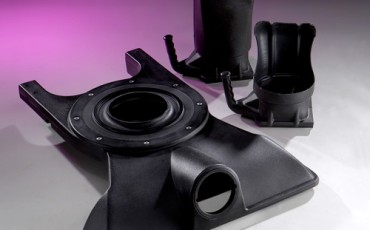
Rotational molding machines support the production of strong, hollow plastic parts in a variety of shapes, sizes, colors, and textures. Compared to injection molding, the tooling that is used costs less and supports faster modifications. Examples of rotational molds include two-piece sheet metal molds and multi-piece aluminum molds with articulating features.
Gregstrom Corporation uses Ferry Rotospeed RS-220 and RS2-3300 rotational molding machines at our Woburn, Massachusetts (USA) manufacturing facility. Each rotomolding machine has offset arms, and we can run parts that are very small to very large. When you partner with us, we can produce plastic parts in a wide range of shapes and sizes from intricate spray manifolds to small boats.
How Rotational Molding Works
As this YouTube video shows, the first step of the rotational molding process involves loading powdered resin into the mold. Using bolts or clamps, the mold is then closed. Next, the mold is moved to an oven where it rotates slowly about two axes simultaneously. This biaxial rotation allows the mold to be coated evenly with plastic, yielding a uniform wall thickness.
The speed of the biaxial rotation can be adjusted to suit the shape and complexity of the plastic part. The powder resin is not centrifugally thrown against the walls of the mold. Rather, the mold runs through the pile of powder material. As heat is transferred through the mold, the resin powder melts and adheres to the mold’s surface, building up layers of plastic.
Rotational Molding Machines: Heating and Cooling
During the molding cycle, the mold’s temperature increases from ambient temperature to several hundred degrees Fahrenheit. In turn, this causes air pressure to build-up inside of the mold. To minimize this pressure build-up, a vent allows air to exit the mold. After the cooling cycle, the vent is removed. In the final part then, there is a hole where the vent was removed.
When all of the plastic material is melted and distributed evenly, the mold is sent to a cooling chamber. There, while continuing its biaxial rotation, the mold is cooled with air, water mist, or a combination of both. The temperature is lowered gradually and the plastic solidifies into its final shape. Then, when the mold and the part are cooled sufficiently, the mold is opened and the part removed.
Choose Rotational Molding from Gregstrom
Do you have questions about rotational molding? Would you like to learn more about rotomolded parts for your specific application, or see some examples of Gregstrom’s rotational molding capabilities? To request a quote or for more information, contact us.



